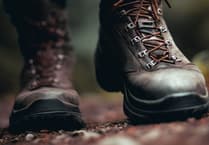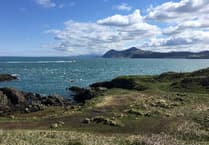A north Wales artist is working closely with Bangor University’s Biocomposites Centre to create new composites derived from natural materials which can be used to create artworks, whilst highlighting the need to care for our natural environment.
Manon Awst, from Anglesey, has been undertaking site-specific research at the Anglesey Fens and Llŷn Fens Special Areas of Conservation in collaboration with experts from Natural Resources Wales’ National Peatland Action Programme, a five-year plan of peatland restoration in Wales.
These areas are home to the most significant and extensive concentration of rich fen habitat in Wales and western Britain, and play an important role in capturing and storing carbon, regulating greenhouse gases, maintaining biodiversity and regulating water.
Manon’s latest body of work explores the unique materiality of peatlands, and will be shared as part of her exhibition, Wetland Dreams (Breuddwyd Gorsiog).
As part of the research process, Manon, who is currently studying for a PhD at Bangor University and works as a public spaces creative co-ordinator at the university’s Pontio Arts and Innovation Centre, has been working with materials specialist Dr Simon Curling from the Biocomposites Centre to bring together various materials to develop new sculptural composites for her current body of work and beyond.
Manon said: “The material that defines the fens is peat and I’ve been exploring it from various perspectives and at different times of the year through site visits with local ecologists, peat specialists, fellow creatives and school pupils.
“Peat has its own timescale – it forms very slowly: each year, 1mm of new peat forms in active and healthy peatland. It reminds me that materials take their own time, and that I have a responsibility as an artist when I choose which materials to work with.”

Although Manon’s project is exploring the unique and vibrant peatlands, using peat was out of the question in any way as it must stay in the ground to perform its valuable functions in terms of carbon store, biodiversity and water regulation.
Nevertheless, its texture when viewed under a microscope provided a point of departure for the artist: “Dr Curling has supported me whilst I’ve explored various methods of bringing together waste grasses from Cors Erddreiniog, powdered mussel shells, lime, wool and biochar, which is produced from the grass.
“It’s an ongoing process of trial and error, and many material samples have gathered in my studio! One of my favourites is made from pulped grass, mussel shells and a wool base, bound together with alginate, a derivative of seaweed.
“It’s been a fascinating process so far, and I look forward to sharing the results with the public over the coming months.”
Dr Curling said: “As researchers, we are used to looking at natural materials from the scientific or product development point of view so working with Manon, with her artistic outlook, is a novel and exciting approach for us and is helping us look at materials in new ways.”
Peter Jones, NRW’s lead specialist on peatland, said: “Peatland is the earth’s most concentrated soil carbon store and restoring them to healthy condition is a key Welsh Government and NRW action to tackle the climate and nature emergencies. We are therefore delighted to work with an artist like Manon Awst who, through her creativity and research, aims to highlight some of the hidden qualities of peatlands for public view.”
Wetland Dreams (Breuddwyd Gorsiog) opened on Saturday, 15 July at Oriel Brondanw, Llanfrothen and there will be an artist talk with Dr Sarah Pogoda from Bangor University at the gallery on Saturday, 19 August.
Manon will also be presenting an element of the work with NRW on Monday, 7 August at the Llŷn ac Eifionydd National Eisteddfod, and a new sculpture will be unveiled at the Anglesey Fens later this year.




